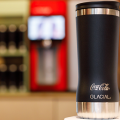At the end of 2020, Coca Cola announced its climate action plan, which aims to reduce greenhouse gas emissions by 30% by 2030, compared to 2019, and to be a “Net Zero Emissions” company by 2040.
In an interview with the Diario Levante newspaper, the Director of Corporate Responsibility of Coca-Cola European Partners Iberia, Carmen Gómez-Acebo, explained her roadmap, which is summarized in reducing the use of energy in our factories and the use of renewable energy sources.
“We plan to make six factories carbon neutral by 2023. When it comes to refrigeration equipment, we will continue to ensure it is HFC (hydrofluorocarbon) free and replace less efficient equipment with efficient models. We will also move to using more electric and hybrid vehicles and we are working on more efficient distribution routes and using other freight transport routes such as rail.”
But they go much further. They will continue to lighten the weight of the packaging. “Lighter packaging generates a smaller carbon footprint and makes the transport system more efficient,” said Gómez-Acebo. This process of lightening can, PET and glass containers means a reduction in the use of virgin material of around 22,000 tonnes.
A recently innovative project -says the director of Coca Cola- “has been developed in the Coca-Cola factory in Barcelona, where last March began the production and distribution of cans with an innovative solution made of recyclable cardboard with PEFC certification, which allows to group the cans in a sustainable and environmentally friendly way. Thanks to this innovation, Coca-Cola in Spain will save more than 18 tons of plastic in a year”.
This is how an article published on the blog of PEFC, the world’s most globally established forestry certification system, describes Coca Cola’s commitment: In 2019 they decided to “develop a secondary cardboard packaging for the 200 ml can packs and, at the end of 2020, to replace the classic film can carrier with a cardboard carrier, CanCollar®, thus reducing the plastic used in Europe by 11,000 tonnes per year”.







